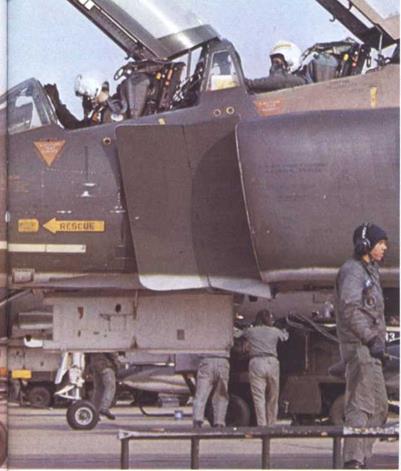McDonnell Douglas F-4 Phantom II
F-4A to F-4S, RF-4, QF-4, EF-4
Origin: McDonnell Aircraft, division of McDonnell Douglas Corp, St Louis, USA: licence production by Mitsubishi, Japan (F-4EJ) and substantial subcontracting by W German industry.
Type: Originally carrier-based all-weather interceptor: now all-weather multi-role fighter for ship or land operation: (RF) all-weather multisensor reconnaissance: (QF) RPV: (EF) defence-suppression aircraft.
Engines: (B, G) two 17,0001b (7711 kg)’thrust General Electric J79-8 single-shaft turbojets with afterburner: (C, D) 17,0001b J79-15: (E, EJ, F) 17,9001b (8120kg) J79-17; (J, N, S) 17,9001b J79-10: (К, M) 20,5151b (9305kg) Rolls-Royce Spey 202/203 two-shaft augmented turbofans. Dimensions: Span 38ft 5in (11 -7m): length (В, C, D, G, J, N, S) 58ft 3in (17-76m): (E. EJ, F and all RF versions) 62ft 11 in or 63ft (19 2m): (К, M) 57ft 7in (17-55m): height (all) 1 6ft 3in (4-96m).
Weights: Empty (B, C,.D, G, J, N) 28,000lb (12,700kg): (E, EJ, F and RF) 29,000lb (13,150kg); (К, M).31,0001b (14,060kg); maximum loaded (B) 54,600lb; (C, D, G, J, К, M, N. RF) 58,000lb (26,308kg); (E, EJ, F) 60,6301b (27,502kg).
Performance: Maximum speed with Sparrow missiles only (low) 91 Omph (1464km/h, Mach 1-19) with J79 engines, 920mph with Spey, (high) 1,500mph (2414km/h, Mach 2• 27) with J79 engines, 1,386mph with Spey; initial climb, typically 28,000ft (8534m)/min with J79 engines, 32,OOOft/min with Spey: service ceiling, over 60,000ft (19,685m) with J79 engines. 60,000ft with Spey; range on internal fuel (no weapons) about 1,750 miles (2817km); ferry range with external fuel, typically 2,300 miles (3700km) (E and variants, 2.600 miles (4184km).

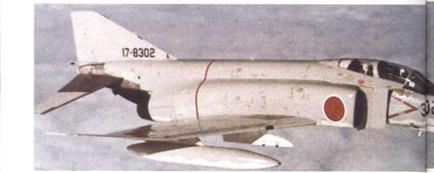
Armament: (All versions except EF, RF. QF which have no armament) four AIM-7 Sparrow air-to-air missiles recessed under fuselage; inner wing pylons can carry two more AIM-7 or four AIM-9 Sidewinder missiles; in
addition all E versions except RF have internal 20mm M-61 multi-barrel gun, and virtually all versions can carry the same gun in external centreline pod; all except RF, QF have centreline and four wing pylons for tanks, bombs or other stores to total weight of 16,0001b (7257kg).
History: First flight (XF4H-1) 27 May 1958; service delivery (F-4A) February 1960 (carrier trials), February 1961 (inventory); first flight (Air Force F-4C) 27 May 1963; (YF-4K) 27 June 1966; (F-4E) 30 June 1967; (EF-4E) 1976.
Users: W Germany, Greece, Iran, Israel, Japan, Saudi Arabia, Singapore (no contract announced), S Korea, Spain, Turkey, UK (RAF, Royal Navy), USA (Air Force, ANG, Navy, Marine Corps).
Development: McDonnell designed the greatest. fighter of the postwar era as a company venture to meet anticipated future needs. Planned as an attack aircraft with four 20mm guns, it was changed into a very advanced gunless all-weather interceptor with advanced radar and missile armament.
In this form it entered service as the F-4A, soon followed by the F-4B used^
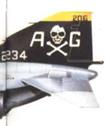
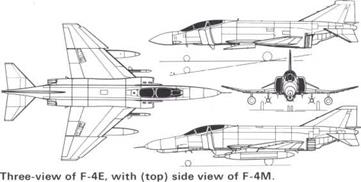 |
Left: An F-4B (since remanufactured as an F-4N) serving with US Navy fighter squadron VF-84 ‘Skull and Crossbones’ aboard USS Independence during the Vietnam conflict.
Below left: The only Phantom Ms not built at St Louis were the 127 F-4EJ series assembled in Japan, mainly by Mitsubishi.
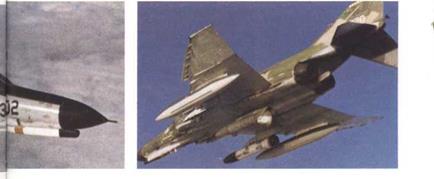
Below: This F-4E is equipped with the advanced AVQ-26 Pave Tack all-weather sighting and weapon-aiming system on a centreline pylon.
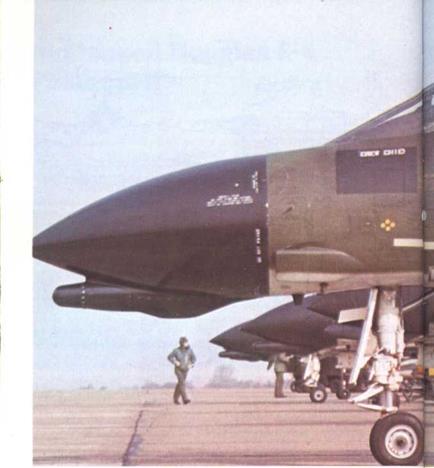
Above: In 1980 the Phantom II was still one of the most important tactical aircraft in the US inventory. This flight line full of F-4Ds could be at any of a dozen TAC or USAFE airbases; they are starting engines ready to move off on a training mission. This was the first purpose-designed version for operation from land bases. Some of this sub-type lack the prominent infra-red detector in the fairing under the radar.
in large numbers (635) by the US Navy and Marine Corps, with Westing – house APQ-72 radar, IR detector in a small fairing under the nose, and many weapon options. Pilot and radar intercept officer sit in tandem and the aircraft has blown flaps and extremely comprehensive combat equipment. A Ipvel Mach number of 2-6 was achieved and many world records were set for speed, altitude and rate of climb. Not replaced by the abandoned F-111 B, the carrier-based Phantom continued in production for 19 years through the F-4G with digital communications. F-4J with AWG-10 pulse-doppler radar, drooping ailerons, slatted tail and increased power, and the N (rebuilt B). In 1961 the F-4B was formally compared with all US Air Force fighters and found to outperform all by a wide margin, especially in weapon load and radar performance. As a result it was ordered in modified form as the F-110, soon redesignated F-4C, for 16 of the 23 Tactical Air Command Wings. The camera/radar/IR linescan RF-4C followed in 1965. In 1964 the Royal Navy adopted the Anglicised F-4K, with wider fuselage housing Spey fan engines and, of 48 delivered to Britain as Phantom FG.1, 28 served with the. Royal
|
|
Navy. The other 20 went to RAF Strike Command, which has also received 120 F-4M (UK designation Phantom FGR.2) which combine the British features with those of the F-4C plus the option of a multi-sensor centreline reconnaissance pod whilst retaining full weapons capability. In the US Air Force the C was followed by the much-improved D with APQ-100 radar replaced by APQ-109, inertial navigation added and many added or improved equipment items. This in turn was followed by the dramatically improved F-4E with slatted wing, internal gun and increased power, the EJ being the version built in Japan and the F being a Luftwaffe version. The Luftwaffe also operate the multi-sensor RF-4E. Australia leased F-4Es from the US government pending delivery of the F-111C. In 1979 deliveries of new aircraft, all assembled at St Louis except for the EJ, i
were completed at 5,057, a record for any supersonic aircraft of any type in the Western world. In addition several large rebuild programmes were in hand including rebuilding 300 F-4J into F-4S with longlife slatted airframes, rebuilding Marine Corps RF-4Bs with new structure and sensors, rebuilding or refitting over 600 Air Force machines (for example with Pave Tack FLIR/laser pods or Pave Spike TV/laser pods) and complete rebuild of 116 F-4D or E Phantoms into the EF-4E Wild Weasel defence-suppression platform with weapons replaced by special electronics (especially the APR-38 system, with large pod on the fin) to detect, locate and classify hostile electromagnetic emissions, and assist other aircraft to destroy them. Some EF aircraft may do their own killing, with Standard ARM, Shrike and Flarm missiles.











